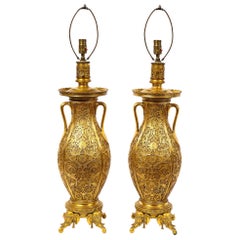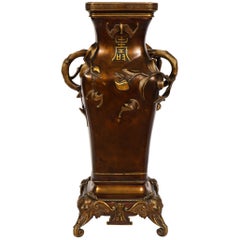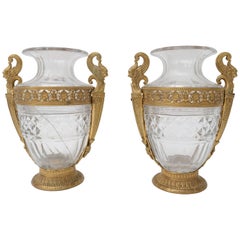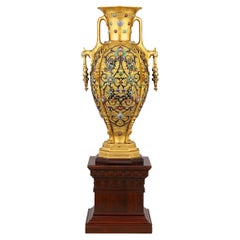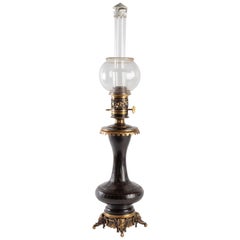Edouard Lievre Decorative Objects
2
to
2
2
2
2
2
Height
to
Width
to
2
2
2
2
2
1,313
741
502
445
Creator: Edouard Lievre
Pair of French Japonisme Ormolu Vases E. Lièvre, Executed by F. Barbedienne
By Edouard Lievre, Ferdinand Barbedienne
Located in New York, NY
An important and monumental pair of very fine 19th century French Japonisme/Orientalist ormolu vases designed by Edouard Lièvre and Executed by Ferdinand Barbedienne. Each body with an oval shape, finely sculpted in a floral design, fringed by orientalist style handles with cartouches, the neck surmounted by a circular pierced scrolling dragon frieze. Each vase resting on a group of four orientalist style jeweled elephant...
Category
1870s French Japonisme Antique Edouard Lievre Decorative Objects
Materials
Bronze
Antique French Bronze Orientalist Style Vase; E. Lievre for the Chinese Market
By Edouard Lievre
Located in New York, NY
This unique French bronze orientalist style vase by Edouard Lievre made for the Chinese market has been exceptionally handcrafted and patinated with gold highlights. Included on the ...
Category
Late 19th Century French Japonisme Antique Edouard Lievre Decorative Objects
Materials
Bronze
Related Items
French Empire Style Bronze and Crystal Vases
Located in West Palm Beach, FL
This pair of French Empire vases date from the 19th century and are of exceptional quality. Unfortunately one of the cut crystal vase has been crac...
Category
Late 19th Century French Empire Antique Edouard Lievre Decorative Objects
Materials
Crystal, Bronze
Ancient Solid Bronze Vase with Chinese or Japanese Elephants
Located in Palermo, Sicily
Ancient solid bronze vase with Chinese or Japanese elephants
Category
Early 1700s Japanese Japonisme Antique Edouard Lievre Decorative Objects
Materials
Bronze
Large Neo-Greek Vase by F. Levillain & F. Barbedienne, France, circa 1890
By Ferdinand Barbedienne, Ferdinand Levillain
Located in PARIS, FR
Important neo-Greek vase in the shape of an Amphora, made in two patina bronze. The body is decorated with a rich continuous frieze in bas-relief presenting a procession of characters carrying their offerings to the temple, underlined by a decoration of theatrical masks among olive trees. The 's'-scroll handles decorated with grape vines, resting only on the shoulder of the vase, are supported by a ram’s head. Numerous palmettes and friezes adorn the whole. Resting on a molded marble circular base.
Biography
Ferdinand Levillain (Paris, 1837-1905) studied under the sculptor Jouffroy (1806-1882), before making his debut in 1861 at the French Artists Salon where he continued to exhibit until 1903. At the 1867 Universal Exhibition in Paris, he was praised for a Neo-Greek style bronze cup he made for the firm Blot and Drouard. He was not to become really famous, however, until 1871 thanks to his association with the great bronze founder Ferdinand Barbedienne, who began to exhibit Neo-Greek style lamps...
Category
1890s French Greek Revival Antique Edouard Lievre Decorative Objects
Materials
Marble, Bronze
Ferdinand Barbedienne, A French Ormolu and Champleve Enamel Jardiniere, C. 1870
By Louis-Constant Sevin, Ferdinand Barbedienne
Located in New York, NY
Ferdinand Barbedienne, A French Ormolu and Champleve Enamel Jardiniere, C. 1870, The Design Attributed to Louis Constant Sevin.
An exceptional qualit...
Category
19th Century French Napoleon III Antique Edouard Lievre Decorative Objects
Materials
Bronze, Enamel, Ormolu
No Reserve
H 5 in W 8 in D 5 in
Vintage Midcentury Chinese Bronze Brutalist Style Vase Vessel
Located in San Diego, CA
Beautiful and unique Chinese bronze cast archaic style ritual vessel or vase. This beautiful piece is ornate in design with simple lines. The vessel stretches outwards while keeping ...
Category
1960s Chinese Chinoiserie Vintage Edouard Lievre Decorative Objects
Materials
Bronze
Ferdinand Barbedienne, a French Ormolu and Champleve Enamel Jardiniere, C. 1870
By Louis-Constant Sevin, Ferdinand Barbedienne
Located in New York, NY
Ferdinand Barbedienne, A French Ormolu and Champleve Enamel Jardiniere, C. 1870, The Design Attributed to Louis Constant Sevin.
An exceptional qualit...
Category
19th Century French Napoleon III Antique Edouard Lievre Decorative Objects
Materials
Bronze, Ormolu, Enamel
Pair of Chinese Bronze Vases
Located in New York, NY
Pair of circa 1930's bronze Chinese vases depicting dragons.
Measurements:
Height: 10"
Diameter: 6"
Category
1930s Chinese Vintage Edouard Lievre Decorative Objects
Materials
Bronze
Bronze Chinese Dragon Vase
Located in San Diego, CA
Wonderfully detailed bronze Chinese dragon vase, circa mid-20th century.
Category
Mid-20th Century Chinese Chinese Export Edouard Lievre Decorative Objects
Materials
Bronze
French 19th Century Pair of Lacquered Bamboos Japonisme Vases
By Ferdinand Barbedienne, Edouard Lievre
Located in Saint-Ouen, FR
A 19th French century pair of Lacquered Bamboos Japonisme vases.
An amazing pair of tall cylindrical bamboo vases decorated in Japanese Gold and Sil-ver Hiramaki-E Lacquer with Pavilions in The Mist and Weaving Figures, Flown Over by a Pair of Cranes. Enclosed in a Sino-Japanese Inspiration Golden and Brown Patina Bronze Mount Featuring Elephant Heads, Partially Openwork Branches and Salamanders Forming Side Handles.
Circa 1870
Attributed to Édouard Lièvre (1828-1886) and Ferdinand Barbedienne (1810-1892)
Édouard Lièvre (1828-1886) is one of the most talented and prolific designer and industrialist of the 19th Century, his repertoire is sometimes Sino-Japanese or Neo-Renaissance, whether in furniture or works of art, we can note in particular the parade bed of Valtesse de La Bigne, furniture commissioned by the painter Édouard Detaille or even Sarah Bernhardt, and the famous works in collaboration with Maison Christofle or those in gilded bronze and cloisonné enamel edited by Ferdinand Barbedienne, presented at the Universal Exhibitions in 1878, 1889 and 1900.
He was both a draftsman, painter, illustrator, engraver, ornamentalist and cabinetmaker, first trained in the studio of the painter Thomas Couture, Lièvre was then fully immersed in the world of decoration, creation and ornamentation and provides designs for manufacturers and merchant-publishers.
Often assisted by his brother Justin, he first produced works of art for his own apartment, seeking out the finest craftsmen to execute his designs for bronzes, ceramics, fabrics and luxury furniture from great virtuosity and great taste. He then collaborated with the cabinet-maker Paul Sormani, as well as haberdasher merchants such as the Escalier de Cristal, bronziers such as Maison Marnyhac and especially Ferdinand Barbedienne as on our vases with bronze mounts characteristics of Edouard Lièvre's work.
Born in 1810, died in Paris in 1892, Ferdinand Barbedienne, the most important caster of bronze pieces of art during the second half of the 19th Century, created and directed in Par-is one of the major artistic foundries of his time. Barbedienne specialized in classical reproductions, whose models were exposed in famous European museums. Their illustrated catalogues included many diverse objects such as busts, ornemental sculpture (clocks, candelabras, cups) sometimes even life-sized and bronzes for furniture. Apart from his own produc-tion, Barbedienne worked for the most renowned sculptors such as Barrias, Clésinger and Carrier-Belleuse. All his works were highly esteemed and he, himself honored by contemporary critics. At the London exhibition in 1851 Barbedienne’s firm won two « Council medals ». At the 1855 Universal Exhibition, he won a medal of honor. The success of Barbedienne’s firm brought him many official commissions, such in about 1860, as Barbedienne supplied bronzes for furniture for the Pompeian Villa of Prince Napoléon-Joseph, located avenue Montaigne in Paris. At the London Universal Exhibition of 1862 Barbedienne won medals in three different categories: Furniture, Silversmith work and Artistic bronzes. Barbedienne was made an officer of the Légion d’Honneur in 1867 and Commander in 1878 when he was compared with « a prince of industry and the king of bronze casting ». His glory did not decline with the passage of the time for at the Universal Exhibition of 1889 the critics thanked Barbedienne for the example he set for other bronze-casters by the perfection of his bronzes.
“Japonisme” in the second half of the 19th century, was a craze for everything that came from Japan or imitated its style. The word was first coined in a series of articles published by Philippe Burty, from May 1872 to February 1873, in the French magazine “la Renaissance Littéraire et Artistique”. Far from the Academic sphere, artists seeking for new ways of expression, appropriated this discovery. Manet and the impressionists led the way to half a century of enthusiasm for Japanese art, and largely contributed to the esthetical revolution Europe experienced between 1860 and the beginning of the twentieth century.
From 1862, The World’s Fairs provoked massive arrivals of fans, kimonos, lacquers, bronzes, silks, prints and books that launched the real era of Japonisme. With those exhibitions, the demand was boosted, the number of merchants and collectors was multiplied, and artists became passionate about this new esthetic. For them, its “primitivism” was probably its most important quality: artists were fond of the Japanese art’s capacity to be close to nature and to reconcile art and society by representing, with a lot of care, the most trivial objects.
In painting, Edouard Manet, Mary Cassatt, Degas, Van Gogh, Gauguin were among those who were deeply inspired by Japanese art, affected by the lack of perspective and shadow, the flat areas of strong color, the compositional freedom in placing the subject off-center, with mostly low diagonal axes to the background. The Japanese iris, peonies, bamboos, kimonos, calligraphy, fish, butterflies and other insects, the blackbirds, cranes and wading birds, the cats, tigers, and dragons were endless sources of inspiration, appropriation, and reinterpretation for European artists. The occidental productions were combining styles and artistic conceptions instead of copying Japanese art slavishly. That is what brings to light the comparison between the artworks of Kitagawa Utamaro and Degas, of Katsushika Hokusai and Van Gogh
The World’s Fairs of 1851 and 1862 in London, those of 1867, 1878, 1889 and 1900 in Paris, of 1873 in Vienna and of 1904 in Saint Louis presented a number of “Japanese-Chinese” installations with earthenware, bronzes, screens and paintings and attracted the largest amounts of visitors In Vienna, the “Japanese village...
Category
1870s French Japonisme Antique Edouard Lievre Decorative Objects
Materials
Bronze
Archaic Chinese Bronze Vase
Located in Marseille, FR
Archaic Chinese bronze vase decorated with elephant heads, work probably from the middle of the 19th century, unfortunately pierced in two places. Measur...
Category
19th Century Antique Edouard Lievre Decorative Objects
Materials
Bronze
F. Barbedienne, A Suite of Three French Ormolu and Champleve Enamel Jardinieres
By Ferdinand Barbedienne
Located in New York, NY
Ferdinand Barbedienne, An Exquisite Suite of Three French Ormolu and Champleve Enamel Jardinieres / Garniture C. 1870, The Design Attributed to Louis Constant Sevin.
Comprising of t...
Category
19th Century French Napoleon III Antique Edouard Lievre Decorative Objects
Materials
Bronze, Enamel, Ormolu
H 5 in W 8 in D 5 in
Pair of Trumpet-Shaped Byzantines Vases, L.C. Sevin&F. Barbedienne, France, 1880
By Louis-Constant Sevin, Ferdinand Barbedienne
Located in PARIS, FR
Signed F. Barbedienne
A pair of charming trumpet-shaped vases in gilt bronze with a polychrome cloisonné enamel decoration, one blue and the other green and red. They feature two annular handles and stand on four feet surmounted by a stylized palm. The vases are ornated with a Byzantine decoration.
The high quality of the enamel is typical of Barbedienne’s production. It enhances this pair of vases especially with the wide range of colours used to create the decoration. The enamel is smooth and shiny and shows many shades to form the Byzantine decoration. The partitioned cloisonné is finely engraved and contributes to the decoration by adopting vegetal and foliage shapes.
The Model
These two vases can be linked to a vase presented by Ferdinand Barbedienne at the 1862 London Universal Exhibition and purchased at this time by the South Kensington Museum (now the Victoria and Albert Museum, London, Inv. 8026-1862). This vase has on its belly a polychrome cloisonné enamel decoration standing out against a turquoise background as show these vases. This decoration, called Byzantine, covers all the vase with coloured arabesques and scrolls. It rests on four claw feet with lion heads from a design near of our vases.
Barbedienne and the Cloisonné Enamel
Ferdinand Barbedienne continously innovated and he revived the use of enamel on art works during the second half of the 19th century. The Sèvres Manufacture enamel workshop had ever tried it in 1854-1855, but Barbedienne was the one who succeeded to join enamel to an industrial decorative objects production. From 1858 “At Mr Barbedienne’s, enamels in copper ornaments have got their former prestige back” (Les bronzes de la Maison Barbedienne, C. Simon, in L’Art du XIXe siècle, 1858, n°21, p. 252). The Barbedienne Company had now an enamel workshop where objects ornamented with oriental style or medieval style enamels were made. Four years after, Barbedienne’s cloisonné...
Category
1880s French Other Antique Edouard Lievre Decorative Objects
Materials
Bronze, Enamel
H 9.45 in Dm 3.75 in
Previously Available Items
World's Fair Bronze Vase By Barbedienne
By Edouard Lievre, Ferdinand Barbedienne
Located in New Orleans, LA
This monumental gilt-bronze and enamel vase marries the imaginative designs of Édouard Lièvre’s ‘le style japonais et chinois’ and the technical prowess of renowned bronzier Ferdinan...
Category
19th Century French Japonisme Antique Edouard Lievre Decorative Objects
Materials
Bronze, Enamel
Antique Bronze Ming Vase, Pumped Up by Edouard Lièvre in Oil Lamp
By Edouard Lievre
Located in Saint-Ouen, FR
Ming vase in antique bronze, mounted by Edouard Lièvre in oil lamp, bronze mounted by Lièvre, from the Napoleon III period
Measures: H 77cm, L 19cm.
Category
17th Century Chinese Napoleon III Antique Edouard Lievre Decorative Objects
Materials
Bronze
19th Century French Barbedienne Bronze and Marble Inkwell by Edouard Lièvre
By Edouard Lievre
Located in New York, NY
19th century French Barbedienne gilded bronze and rouge griotte marble inkwell by Edouard Lièvre (French, 1828-1886). The "F. Barbedienne" foundry mark inscribed on the rim can be se...
Category
Late 19th Century French Napoleon III Antique Edouard Lievre Decorative Objects
Materials
Marble, Bronze
H 3.75 in W 3 in D 3.5 in
Edouard Lievre decorative objects for sale on 1stDibs.
Edouard Lievre decorative objects are available for sale on 1stDibs. These distinctive items are frequently made of metal and are designed with extraordinary care. There are many options to choose from in our collection of Edouard Lievre decorative objects, although gold editions of this piece are particularly popular. If you’re looking for additional options, many customers also consider decorative objects by L'Escalier de Cristal, Theodore Deck, and Charles Masse. Prices for Edouard Lievre decorative objects can differ depending upon size, time period and other attributes — on 1stDibs, these items begin at $26,250 and can go as high as $185,360, while a piece like these, on average, fetch $138,500.
